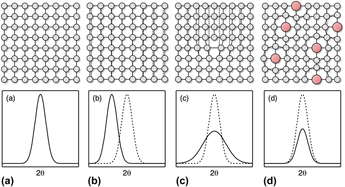Crossref Citations
This article has been cited by the following publications. This list is generated based on data provided by
Crossref.
Wu, Chan-Sheng
Tsai, Ping-Hsiu
Kuo, Chia-Ming
and
Tsai, Che-Wei
2018.
Effect of Atomic Size Difference on the Microstructure and Mechanical Properties of High-Entropy Alloys.
Entropy,
Vol. 20,
Issue. 12,
p.
967.
Su, Yanqing
Xu, Shuozhi
and
Beyerlein, Irene J
2019.
Ab initio-informed phase-field modeling of dislocation core structures in equal-molar CoNiRu multi-principal element alloys.
Modelling and Simulation in Materials Science and Engineering,
Vol. 27,
Issue. 8,
p.
084001.
Jansson, U.
and
Lewin, E.
2019.
Carbon-containing multi-component thin films.
Thin Solid Films,
Vol. 688,
Issue. ,
p.
137411.
Cao, Weitao
Zheng, Mingjie
Ding, Wenyi
Mao, Xiaodong
Wang, Chao
Wang, Wei
and
Xin, Jingping
2019.
Large relrod extension induced by lattice distortion in high entropy alloy.
Materials Research Express,
Vol. 6,
Issue. 6,
p.
066558.
Sokkalingam, Rathinavelu
Muthupandi, Veerappan
Sivaprasad, Katakam
and
Prashanth, Konda Gokuldoss
2019.
Dissimilar welding of Al0.1CoCrFeNi high-entropy alloy and AISI304 stainless steel.
Journal of Materials Research,
Vol. 34,
Issue. 15,
p.
2683.
Ge, Huijuan
and
Tian, Fuyang
2019.
A Review of Ab Initio Calculation on Lattice Distortion in High-Entropy Alloys.
JOM,
Vol. 71,
Issue. 11,
p.
4225.
Jafary-Zadeh, Mehdi
Khoo, Khoong Hong
Laskowski, Robert
Branicio, Paulo S.
and
Shapeev, Alexander V.
2019.
Applying a machine learning interatomic potential to unravel the effects of local lattice distortion on the elastic properties of multi-principal element alloys.
Journal of Alloys and Compounds,
Vol. 803,
Issue. ,
p.
1054.
Owen, L.R.
and
Jones, N.G.
2020.
Quantifying local lattice distortions in alloys.
Scripta Materialia,
Vol. 187,
Issue. ,
p.
428.
Anand, G.
Eisenbach, Markus
Goodall, Russell
and
Freeman, Colin L.
2020.
Electron spin mediated distortion in metallic systems.
Scripta Materialia,
Vol. 185,
Issue. ,
p.
159.
Nygård, Magnus M.
Sławiński, Wojciech A.
Ek, Gustav
Sørby, Magnus H.
Sahlberg, Martin
Keen, David A.
and
Hauback, Bjørn C.
2020.
Local order in high-entropy alloys and associated deuterides – a total scattering and Reverse Monte Carlo study.
Acta Materialia,
Vol. 199,
Issue. ,
p.
504.
Brenne, F.
Mohammed, A.S.K.
and
Sehitoglu, H.
2020.
High resolution atomic scale characterization of dislocations in high entropy alloys: Critical assessment of template matching and geometric phase analysis.
Ultramicroscopy,
Vol. 219,
Issue. ,
p.
113134.
Lewin, Erik
2020.
Multi-component and high-entropy nitride coatings—A promising field in need of a novel approach.
Journal of Applied Physics,
Vol. 127,
Issue. 16,
Kirnbauer, A.
Kretschmer, A.
Koller, C.M.
Wojcik, T.
Paneta, V.
Hans, M.
Schneider, J.M.
Polcik, P.
and
Mayrhofer, P.H.
2020.
Mechanical properties and thermal stability of reactively sputtered multi-principal-metal Hf-Ta-Ti-V-Zr nitrides.
Surface and Coatings Technology,
Vol. 389,
Issue. ,
p.
125674.
Kaufman, Jonathan
and
Esfarjani, Keivan
2021.
Tunable lattice distortion in MgCoNiCuZnO5 entropy-stabilized oxide.
Journal of Materials Research,
Vol. 36,
Issue. 8,
p.
1615.
Yu, Xiwen
Wang, Bing
Wang, Cheng
Zhuang, Chen
Yao, Yingfang
Li, Zhaosheng
Wu, Congping
Feng, Jianyong
and
Zou, Zhigang
2021.
2D High‐Entropy Hydrotalcites.
Small,
Vol. 17,
Issue. 45,
Pickering, Ed J.
Carruthers, Alexander W.
Barron, Paul J.
Middleburgh, Simon C.
Armstrong, David E. J.
and
Gandy, Amy S.
2021.
High-Entropy Alloys for Advanced Nuclear Applications.
Entropy,
Vol. 23,
Issue. 1,
p.
98.
Farkas, Diana
2021.
Deformation behavior of a model high entropy alloy from atomistic simulations.
Materials Science and Engineering: A,
Vol. 812,
Issue. ,
p.
141124.
Dasari, Sriswaroop
Sharma, Abhishek
Byers, Todd A.
Glass, Gary A.
Srivilliputhur, Srinivasan
Rout, Bibhudutta
and
Banerjee, Rajarshi
2021.
Proton irradiation induced chemical ordering in an Al0.3CoFeNi high entropy alloy.
Applied Physics Letters,
Vol. 119,
Issue. 16,
Adomako, Nana Kwabena
Shin, Giseung
Park, Nokeun
Park, Kyoungtae
and
Kim, Jeoung Han
2021.
Laser dissimilar welding of CoCrFeMnNi-high entropy alloy and duplex stainless steel.
Journal of Materials Science & Technology,
Vol. 85,
Issue. ,
p.
95.
Geslin, Pierre-Antoine
Rida, Ali
and
Rodney, David
2021.
Microelasticity model of random alloys. Part II: displacement and stress correlations.
Journal of the Mechanics and Physics of Solids,
Vol. 153,
Issue. ,
p.
104480.





